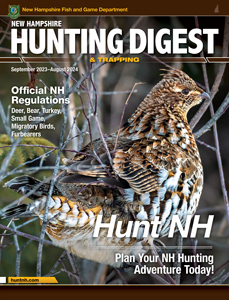Turkey Hunting
Wild turkeys in New Hampshire are a wildlife restoration success story. The state now offers generous spring and fall turkey hunting opportunities, as well as a special youth hunt. The highest concentration of turkeys is in the Connecticut River Valley—though they are well distributed throughout the state, and their clucks, purrs, and gobbles may be heard just about anywhere!
Turkey Hunting Licensing Requirements
Adult hunters (16 or older) must have a Regular N.H. Hunting, Combination, or Archery License and a Turkey License to hunt turkeys. A Small Game License does not allow for the hunting of turkeys. Youth hunters (under 16 years of age) do not need a Hunting, Combination, or Archery license, but they do need a turkey license. Each Turkey License comes with 2 tags which may be used in any order and allow the take of two (2) turkeys per year. Turkey hunters may take one (1) male or bearded turkey during the spring season and a second turkey of either sex during the fall. Or, hunters may take two (2) male or bearded turkeys during the spring season. However, the first spring turkey shall be legally registered before the second spring turkey can be taken. One of the spring turkeys may be taken statewide, but the other spring turkey shall only be taken in WMUs H1, H2, I1, J2, K, L, or M. A hunter may not take two (2) spring birds in WMU's A-G, I2, or J1. One (1) or two (2) turkeys may also be taken during the youth weekend, however all spring season registration and WMU regulations apply. The total fall season bag limit is one (1) turkey and hunting may be done statewide with bow and arrow during the fall archery season, with a crossbow in WMU L or M during the archery season, or with a shotgun or crossbow during the fall shotgun season in those units where allowed (see Turkey Hunting Seasons).
Turkey Hunting Regulations
Hunting Hours:
- Fall: ½ hour before sunrise to ½ hour after sunset.
- Spring: ½ hour before sunrise to 12 noon.
Turkeys must be tagged immediately upon killing. Registration of a fully feathered intact carcass is required online or at the closest open registration station within 24 hours. The turkey may be gutted. See Deer/Turkey Registration Stations for a list of Turkey Registration Stations.
Shotguns, with the following shot and loads:
- between 10 and 20 gauge inclusively, with shot size of #4 and smaller, in hunting rather than target loads; or
- 28 gauge and .410, with shot sizes #7 through #9, a minimum shot density of 18 grams per cubic centimeter (G/CC), and a minimum barrel length of 18 inches
A person who has taken a turkey may assist another properly licensed turkey hunter by calling only. The person assisting by calling shall not possess a bow and arrow, crossbow or firearm (other than a pistol or revolver).
Archery/Crossbows
Archers and crossbow users must have their name and address on arrows or bolts. Fixed blade broadheads cannot be less than ⅞ inches wide; there is no upper size limit. Retractable blade broadheads are permitted (cannot be less than ⅞ of an inch wide when open). Minimum bow and arrow draw weight for turkeys is 30 lbs. Crossbows must meet the requirements on Deer Hunting Regulations, and are allowed as described in the Crossbows section in License Information.
It Is Unlawful to:
- Possess a turkey that hasn’t been properly tagged. Upon killing a turkey the tag shall be filled out and immediately attached to the turkey.
- Take a turkey with a rifle, dogs (during spring season), bait, electronic calling devices, live decoys, by cooperative drives or with an air rifle.
- Take a turkey while the turkey is in a tree.
- Beginning in 2023, no person shall take a turkey by reaping or fanning. Reaping is defined as the practice of stalking or approaching a turkey while holding, wearing, or using a real or artificial turkey fan as camouflage. Fanning is defined as the practice of staying in a stationary position while holding, wearing, or using a real or artificial turkey fan as camouflage to entice a turkey to approach the hunters' position.


